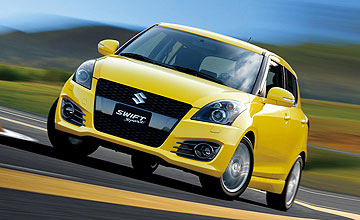BY MIKE COSTELLO | 13th Apr 2012

Available exclusively for now in five-door hatchback guise, the Japanese-built Sport shares the mantle as Australia’s cheapest ‘hot’ hatch with the more powerful (by 3kW and 6Nm) but 170kg heavier Hyundai Veloster that was launched earlier this month.
Suzuki Australia general manager Tony Devers said the new Sport represents an evolution of the Swift flagship that is faster and more efficient than ever before while retaining the “essence of the Suzuki philosophy”.
“The engineering team was driven by the goal of creating the ultimate Swift, but one that was within reach of all hot-hatch fans,” he said.
Power comes from a tweaked version of the revvy 1.6-litre four-cylinder petrol found in the previous-generation Swift Sport, with outputs boosted to 100kW at 6900rpm (up 8kW) and 160Nm (up 12Nm).
These figures are also 30kW and 30Nm up on the garden-variety 1.4-litre Swift hatchback line-up.
The brand has not released any local spint times, but has said that tests conducted in Japan indicate a zero to 100km/h time of “just over eight seconds”.
While the basic structure of the engine remains the same as it was in the previous iteration of the Sport, Suzuki has fitted smoother intake ports, revised variable valve opening times and made the intake side valve lift larger than before.
The engine is matched to an all-new six-speed manual gearbox (compared to the five-speeder in its predecessor and mainstream current Swifts) specially developed for the Sport.
Also available for an extra $2000 will be a new continuously variable transmission (CVT) featuring a seven-speed manual mode and paddle shifters on the steering wheel.
First shipments of the CVT model arrive next month, with Australia to be the first market in the world to receive the new transmission. Suzuki Australia expects 70 per cent of Swift Sport sales will be CVT variants.
Mr Devers said he predicts 200 sales of the Sport per month once the CVT comes on line. Total Swift sales in 2011 – including the now-discontinued previous Sport – were 12,388 units, meaning the new halo model will make up a significant percentage of total volume.
Despite being 120mm longer than its predecessor (and 40mm longer than a regular 3850mm Swift, thanks to its different bumpers) and featuring more standard equipment, the new Sport’s kerb weight of 1060kg is 30kg lighter than before.
The new transmissions and lighter kerb weight also help give the Sport better fuel efficiency than before, with the manual variant achieving 6.5 litres per 100km on the combined cycle - 11 per cent better than the previous model.
The new CVT version is better still, with official figures of 6.1L/100km.
Said to be inspired by the Swifts used in the Junior World Rally Championship, the Sport’s exterior is differentiated from the regular Swift by its new 17-inch wheels and a body kit including a roof spoiler, sports seats and steel pedals.
The addition of new side skirts help give the car a lower appearance, while the rear-end feature more cylindrical tail-lights, twin tail pipes and a metallic diffuser.
Stiffer springs front and rear (15 per cent and 30 per cent respectively) and additional springs on the front struts are said to transform the little hatch’s handling through the twisties.
Furthermore, improved directional stability of the torsion beam rear-end - via stiffer mounting bushes, larger wheel bearings and a stronger rear trailing arm - are claimed to improve high speed stability, making the new Sport the “sportiest experience Suzuki (cars) has ever offered”.
The Sport’s new rims and low-profile tyres were developed specifically for the Swift and produced using a new flow-form manufacturing process that is claimed to save 1kg per corner.
Greater refinement levels than before come courtesy of the use of higher-strength steel, aiding body rigidity, as well as increased rigidity in the joints between components and more comprehensive sound insulation throughout the cabin.
Standard equipment includes automatic climate-control, an MP3 sound system with Bluetooth and USB connectivity, cruise control, red-stitched sports seats, leather steering wheel with audio, cruise and phone controls, stainless steel pedals and bi-Xenon headlights.
As expected, the Sport shares the maximum five-star ANCAP safety rating achieved by lesser members of the Swift range, and gets the full suite of seven airbags, ESC stability control and ABS brakes with electronic brake-force distribution.
Six exterior paint colour choices are available, including Champion Yellow, Ablaze Red, Boost Blue, Snow White, Premium Silver and Super Black.